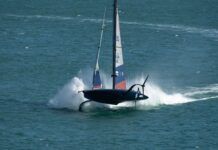I have a 1997 Alerion Express 28 that has a lead keel, and in the course of fairing it this winter, I discovered a defect (see pictures below). Its like a rusty lesion, about three-eighths of an inch deep. I keep attacking it with a wire brush in an electric drill, but the “rust” seems to just go deeper and deeper. What is this, and what should I do about it?

Joe Guidos
Variable
Alerion Express 28
Milford, Conn.
Keel voids of this size are quite common, and its one reason why you don’t see bare lead at boat shows or in the dealers lot. Casting imperfections and partial, localized collapse of the sand mold cause these voids and much worse. When voids form around the support for the keel bolts, bad things happen.
Narrow, high-aspect keels tolerate this far less, and its one of the reasons carbon or high-modulus steel fins and ballast bulbs now rule in that realm.
We forwarded this readers question on to the folks at Alerion, who then passed it on to Mars Metal, a Canadian-based metal manufacturer and one of the most prominent manufacturers of lead keels. Heres what they suggested.
“Advise the customer to excavate as far as he can into the keel, ideally getting under the scar tissue. Thoroughly clean the area with solvent to remove any dusty residue. Mix a small amount of Interprotect 2000e epoxy barrier coat and wire brush it as deeply into the excavated area as possible and allow to set up. Fill the void with a two-part epoxy fairing compound and allow it to cure. Sand the area smooth and fair with the keel. Then fair the body (might get away with one application…maybe more). Spot-prime the repaired area with five or six coats of Interprotect 2000 to get good barrier coat coverage, and then finish fairing the keel. Its very important that multiple coats of the barrier coat be applied to the affected area and the entire refaired keel surface. The more paint, the better the long-term protection. Five, six, or even seven good, thick, roller-applied coats of the barrier paint are great.” Finish with a compatible antifouling paint.
stinky bilge continued
Further investigation into ways to rid bilges of residual diesel fuel fumes (“Practical Sailor Advisor,” April 2007) yielded yet another option. This option is faster, and doesn’t require cleansers or chemicals: Use a hot-water pressure washer. The hot water emulsifies any fuel residue and the elevated temperature raises diesels vapor pressure. Caution should be used when doing this, if there are enough fumes, they could reach an ignitable state, however, its difficult for this to occur unless there is free-standing fuel pooled in the bilge. (Diesel fuel doesn’t produce enough fumes to be flammable until about 140 degrees F, depending on the type of fuel.) The high volume of water vapor that is in the air during the washing process makes any ignition unlikely. The boat should be force-ventilated during the process.






































